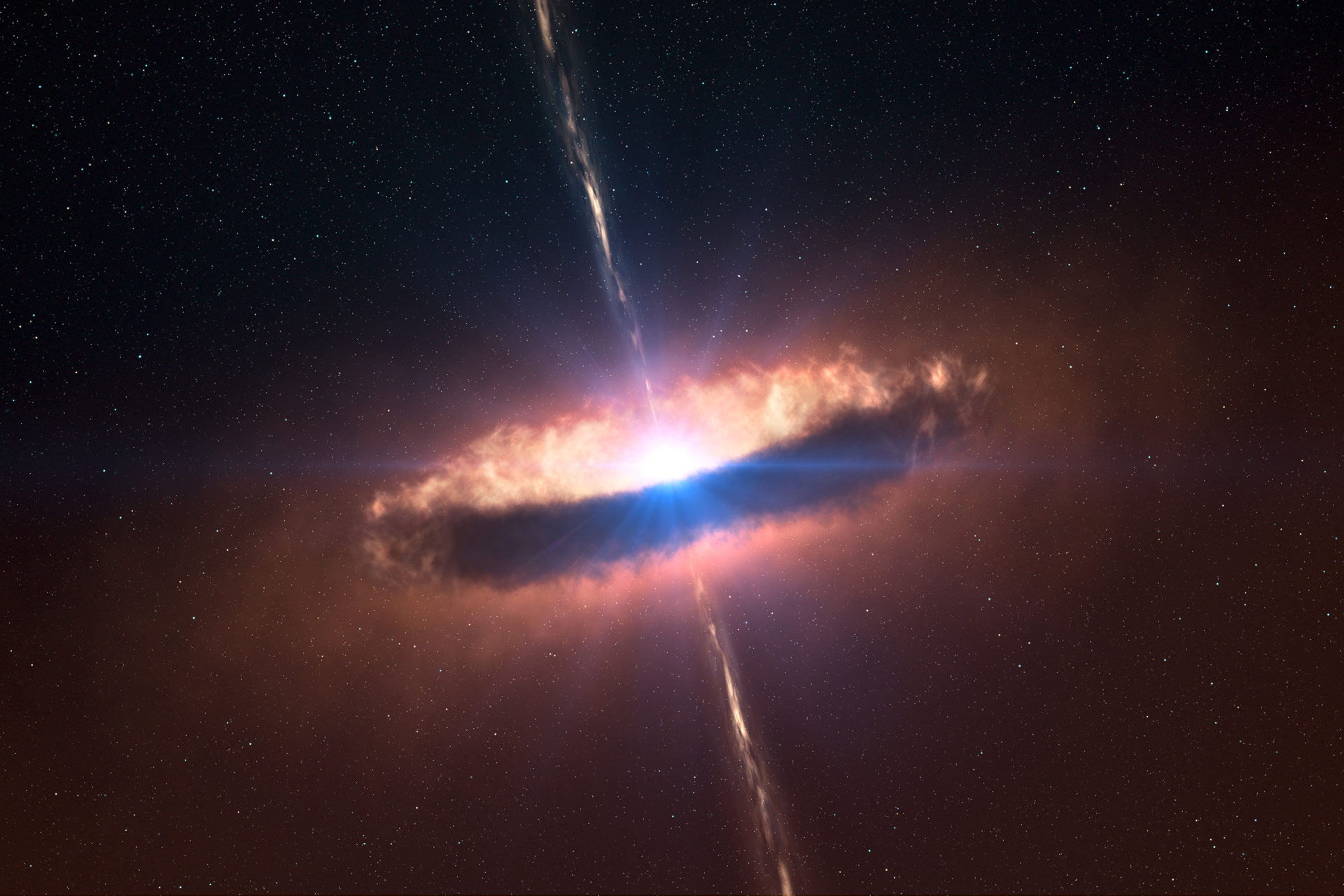Astrophysical jets in X-ray binaries

Astrophysical jets are among the most spectacular phenomena in the universe: they are powerful streams of matter travelling close to the speed of light [4,6].
Jets are associated with accretion processes across all physical scales, from protostars to supermassive black holes. Attracted by the gravity of the accreting object, matter falls towards it, forming a so-called accretion disk: in this process, however, a fraction of particles is accelerated at speeds that can be close to the speed of light, giving rise to two collimated beams along the direction orthogonal to the accretion plane.
Jets have great relevance in many topics of Astrophysics: they are unique laboratories to understand the particle acceleration from compact objects, and to study the strong-gravity regions from where they can be launched; they affect the launching system (by removing matter and power) as well as the surrounding medium (for example, the energy feedback of relativistic jets in supermassive black holes affects the star formation in the host galaxy); and they are believed to be the sources of the fastest-travelling particles in the Universe, the cosmic rays.
Although in recent years our understanding of jet physics has been increasing, there are still many fundamental open questions, including: how are jets launched, accelerated and collimated? What is their kinetic and radiative power? What is their composition?
In our group, we study jets in X-ray binaries, i.e. systems where a stellar-mass compact object (black hole or neutron star) accretes matter from a gravitationally bounded companion star. In these systems, the accretion rate varies on timescales that are easily accessible to our studies - ranging from years to milliseconds - making them the optimal laboratories to study the Physics of jets.
We approach the topic from both an observational and theoretical/interpretative angle! We obtain and collect data over the whole electromagnetic range, in particular near-infrared, optical, X-rays and radio, arranging often (or participating in) ambitious campaigns that involve the simultaneous use of multiple telescopes around the World. We can summarize our scientific interest in jets with the following three lines of research:
- Study of the multi-wavelength fast variable jet emission and its connection with the variable accretion flow. We use state-of-the-art instrumentations, from space and from the ground, to observe the fastest variability - tens of milliseconds! - simultaneously at different wavelengths and we apply modern advanced techniques to extract physical information about them (including how they are launched, what is their geometry, magnetic field, etc.) [3,5,6,8,9]. We have been the first in the World to obtain high time resolution observations of jets in the infrared band [3] and to discover that jets can vibrate in a quasi-periodic way [6], and we keep collecting amazing data in this band, and simultaneously in X-rays and often radio [8,9].
- Long-term monitoring of the broad-band jet emission. We use a number of telescopes of all sizes to study how the full jet spectral properties evolve with time. We have an ongoing monitoring program to collect optical-to-infrared data of many objects, which we use to model the jet broad-band energy spectrum in collaboration with a large number of colleagues across the planet [1].
- Theoretical modelling of jet radiative properties. We collaborate with theoreticians around the planet to develop state-of-the-art numerical models for the variable multi-wavelength emission from jets in X-ray binaries [2,7].
If you are interested in a thesis regarding Astrophysical Jets here you can find available theses about this topic.
Involved group members: Piergiorgio Casella, Giulia Illiano
References
[1] Baglio, M.C., Russell, D.M., Casella, P., et al, 2018, The Astrophysical Journal 867, 114, “A Wildly Flickering Jet in the Black Hole X-Ray Binary MAXI J1535-571”
[2] Casella, P., and Pe’er, A., 2009, The Astrophysical Journal, 703, 1, “On the role of the magnetic field on jet emission in X-ray binaries”
[3] Casella, P., et al., 2010, The Astrophysical Journal, 404, L1, “Fast infrared variability from a relativistic jet in GX 339-4”
[4] Fender 2006, in: Compact stellar X-ray sources. Lewin & van der Klis. Cambridge Astrophysics Series, No. 39. Cambridge University Press, “Jets from X-ray binaries”
[5] Gandhi et al. 2017, Nature Astronomy, 1, 859, “An elevation of 0.1 light-seconds for the optical jet base in an accreting Galactic black hole system”
[6] Kalamkar, M., Casella, P., et al., 2016, Monthly Notices of the Royal Astronomical Society, 460, 3284, “Detection of the first infra-red quasi-periodic oscillation in a black hole X-ray binary”
[6] Maccarone, T. J., Gallo, E., Heinz, S., Miller-Jones, J. C. A., Casella P., Eikenberry, S., Gandhi, P., et al., 2019, "Astro2020 Science White Paper: Compact Stellar Jets"
[7] Pe'er, A., Casella, P., 2009, ApJ, 699, 1919, “A Model for Emission from Jets in X-Ray Binaries: Consequences of a Single Acceleration Episode”
[8] Tetarenko, A, Casella, P., et al., 2021, Monthly Notices of the Royal Astronomical Society, 504, 3862, “Measuring fundamental jet properties with multiwavelength fast timing of the black hole X-ray binary MAXI J1820+070”
[9] Vincentelli, F, Casella, P., et al., 2021, Monthly Notices of the Royal Astronomical Society, 503, 614, “Fast infrared variability from the black hole candidate MAXI J1535-571 and tight constraints on the modelling”